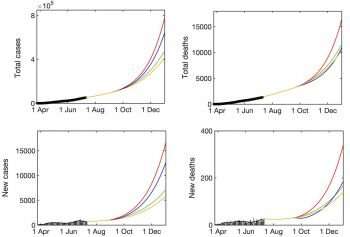
Enabling employees to work from home is more effective than keeping children off school or shielding the over 60s in reducing new COVID infections, new deaths and total deaths. That’s the finding from new research by two University of Sussex mathematicians.
Dr. Konstantin Blyuss and Dr. Yuliya Kyrychko were given access to official COVID data from Ukraine, which they used to model four scenarios: reducing school interactions by 30%; reducing workplace interactions by 30%; shielding half of the over 60s population; and no interventions at all.
The Sussex team worked with Dr. Igor Brovchenko from the Institute of Mathematical Machine and System Problems in Kyiv, on behalf of the working group of the National Academy of Sciences of Ukraine—the Ukraine’s equivalent of the Science Advisory Group for Emergencies. The authors believe their findings are applicable to any country in the world, and back up previous research.
The team found that reducing school contacts by 30% was more effective at both reducing new infections and new deaths than shielding the over 60s. This may be because children and young people naturally tend to interact with more people than older people.
But the scenario with the biggest impact on new infections and new deaths—and crucially also total deaths in the long term—was reducing workplace contacts by 30%. This can be explained by a combination of the higher mortality rate among 40–60-year-olds, and also the fact that if they’re not catching the infection, they are less able to pass it on to older people. The authors believe that promoting working from home and other ways of reducing work contacts may be the most efficient way of controlling the spread of COVID-19.
Dr. Yuliya Kyrychko, a Reader in Mathematics from the School of Mathematics and Physical Sciences at the University of Sussex, said:
“Our modeling shows that the single most effective way to reduce the spread and deaths from COVID is to enable people to work from home. We found that a 30% reduction in workplace interactions led to 62% reduction in new infections and 54% reduction in new deaths by the end of 2020 compared with no additional interventions.”
Dr. Konstantin Blyuss, a Reader in Mathematics from the School of Mathematics and Physical Sciences at the University of Sussex, said:
“Our modeling shows that if you want to reduce the number of new cases and deaths, then it’s workplace interactions which are the key. While shielding the over 60s and reducing contact between school children do, of course, play an important role in tackling COVID-19, neither is as effective in reducing overall transmissions and deaths as encouraging people to work from home where they can.”
The findings support previous research by Sante Publique France (the nation’s public health agency) published in August 2020 showing that the biggest source—26% – of all new COVID infections in France arose from the workplace. One observational study published in June 2020 using data from Hong Kong also showed that the biggest contribution to reducing infections in an epidemic’s early stages was employers allowing people to work from home.
The paper “Mathematical modeling of dynamics and containment of COVID-19 in Ukraine’ is published in a pre-print and has been submitted for publication.

